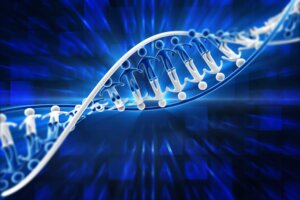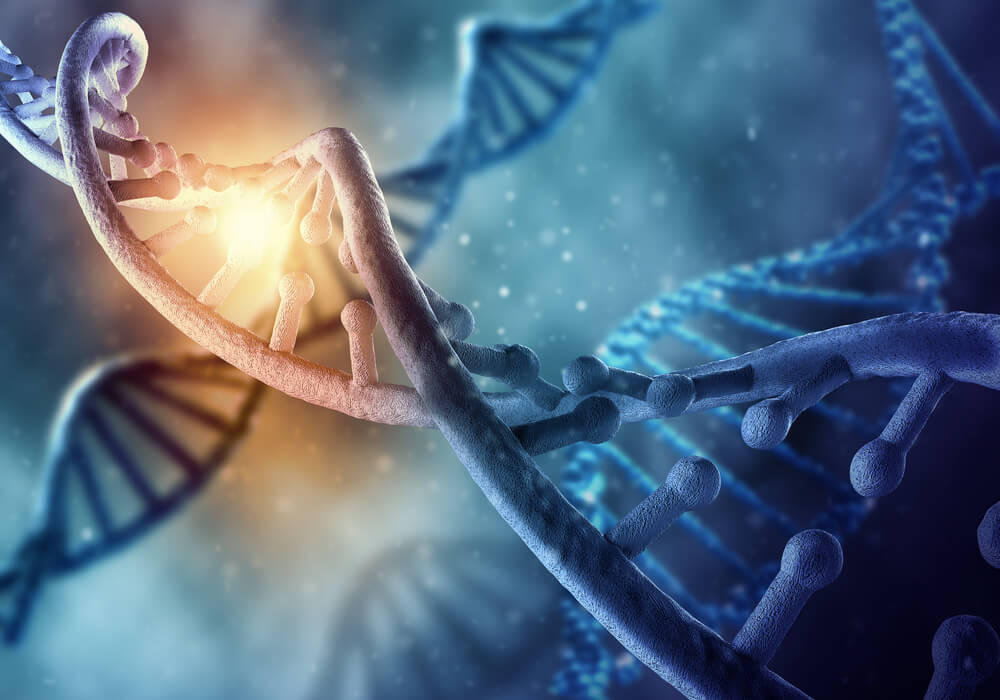The Human Genome

The human genome is the DNA sequence contained in the 23 pairs of chromosomes, in which we find our genes. The human genome contains the encoded information necessary for the synthesis of human proteins.
History of the human genome
In the 19th century, Miescher discovered a new material in cells, more specifically from their nuclei, with a high content of phosphorus. He called it nuclein. Later, in 1953, using X-ray diffraction carried out by R. Franklin, Watson, and Crick, they determined the double helix structure of DNA.
In 1990, an ambitious project called the Human Genome Project was started, which aimed to sequence the entire human genome; it was successfully concluded in 2003. From here, a new era in medical research based on genomics began.

Composition, components, and structure of the human genome
The genome is made up of chromosomes, which are ultracondensed sequences of DNA found in the cell nucleus. There are 23 pairs, one of which is the chromosome that determines the person’s sex. Genes are contained in these chromosomes. Only 1.5% of the genome corresponds to coding sequences. There are between 20,000 and 25,000 human genes.
A gene is a piece of DNA that contains the basic information necessary for the synthesis of a protein or RNA. Genes are made up of the promoter sequence, which is responsible for regulating expression, the sequence to be transcribed (exons), and introns, which are DNA sequences that are located between exons and that aren’t going to be transcribed.
DNA or deoxyribonucleic acid is a polymer of nucleotides. In turn, each nucleotide is made up of a phosphate group, a carbohydrate called deoxyribose and a nitrogen base (thymine, adenine, cytosine or guanine). The different nitrogenous bases differentiate one nucleotide from another and are used in the naming of each DNA sequence.
The bases are joined together, following the AT and CG complementarity, by means of hydrogen bonds. Thus, the double helix structure that DNA adopts is due to the fact that there are two nucleotide chains linked by hydrogen bonds.

Genetic diseases and disorders
Pathologies caused by an alteration of the genome are called genetic diseases or disorders. They can be inherited, if the altered gene is found in germ cells, or non-inherited, if the gene is in somatic cells.
Since genes are the fragments in which information for protein synthesis is stored, a mutation in a gene causes an error in the synthesis of proteins and results in their malfunction.
There are many genetic diseases, and some of the best known are:
- Down’s Syndrome
- Hemophilia
- Colour blindness
- Type 1 diabetes
- Some types of cancer
Mitochondrial genome
This is the genome that’s found in the mitochondria rather than in the nucleus of the cell. The mitochondrion is a cellular organelle that participates in metabolism. It comes from prokaryotic organisms that were taken up by ancestral eukaryotic cells in the course of evolution.
Mitochondrial DNA is only inherited from the mother and has only 37 genes. It has the peculiarity that 97% of this genome are coding sequences.
Gene therapy
Gene therapy is an experimental technique that involves using genes to treat or prevent disease. The most common form of gene therapy involves inserting a normal gene to replace an abnormal one. Although much is expected from this therapy, it’s still experimental.
The human genome is the DNA sequence contained in the 23 pairs of chromosomes, in which we find our genes. The human genome contains the encoded information necessary for the synthesis of human proteins.
History of the human genome
In the 19th century, Miescher discovered a new material in cells, more specifically from their nuclei, with a high content of phosphorus. He called it nuclein. Later, in 1953, using X-ray diffraction carried out by R. Franklin, Watson, and Crick, they determined the double helix structure of DNA.
In 1990, an ambitious project called the Human Genome Project was started, which aimed to sequence the entire human genome; it was successfully concluded in 2003. From here, a new era in medical research based on genomics began.

Composition, components, and structure of the human genome
The genome is made up of chromosomes, which are ultracondensed sequences of DNA found in the cell nucleus. There are 23 pairs, one of which is the chromosome that determines the person’s sex. Genes are contained in these chromosomes. Only 1.5% of the genome corresponds to coding sequences. There are between 20,000 and 25,000 human genes.
A gene is a piece of DNA that contains the basic information necessary for the synthesis of a protein or RNA. Genes are made up of the promoter sequence, which is responsible for regulating expression, the sequence to be transcribed (exons), and introns, which are DNA sequences that are located between exons and that aren’t going to be transcribed.
DNA or deoxyribonucleic acid is a polymer of nucleotides. In turn, each nucleotide is made up of a phosphate group, a carbohydrate called deoxyribose and a nitrogen base (thymine, adenine, cytosine or guanine). The different nitrogenous bases differentiate one nucleotide from another and are used in the naming of each DNA sequence.
The bases are joined together, following the AT and CG complementarity, by means of hydrogen bonds. Thus, the double helix structure that DNA adopts is due to the fact that there are two nucleotide chains linked by hydrogen bonds.

Genetic diseases and disorders
Pathologies caused by an alteration of the genome are called genetic diseases or disorders. They can be inherited, if the altered gene is found in germ cells, or non-inherited, if the gene is in somatic cells.
Since genes are the fragments in which information for protein synthesis is stored, a mutation in a gene causes an error in the synthesis of proteins and results in their malfunction.
There are many genetic diseases, and some of the best known are:
- Down’s Syndrome
- Hemophilia
- Colour blindness
- Type 1 diabetes
- Some types of cancer
Mitochondrial genome
This is the genome that’s found in the mitochondria rather than in the nucleus of the cell. The mitochondrion is a cellular organelle that participates in metabolism. It comes from prokaryotic organisms that were taken up by ancestral eukaryotic cells in the course of evolution.
Mitochondrial DNA is only inherited from the mother and has only 37 genes. It has the peculiarity that 97% of this genome are coding sequences.
Gene therapy
Gene therapy is an experimental technique that involves using genes to treat or prevent disease. The most common form of gene therapy involves inserting a normal gene to replace an abnormal one. Although much is expected from this therapy, it’s still experimental.
- Barreno, P. G. (2002). El genoma humano. Arbor.
- Aziani Samek-Lodovici, A. (2000). El Proyecto Genoma Humano. Studium Veritatis. https://doi.org/10.35626/sv.1.2000.262
- Collado, C. A. M. (2001). Genoma humano. Dermatologia Revista Mexicana.
Este texto se ofrece únicamente con propósitos informativos y no reemplaza la consulta con un profesional. Ante dudas, consulta a tu especialista.







